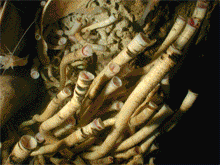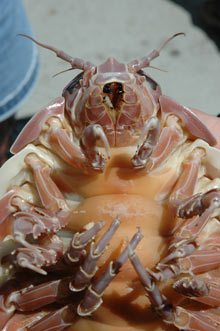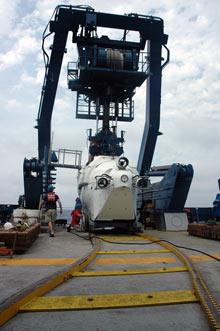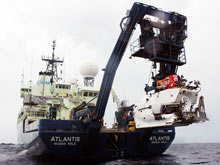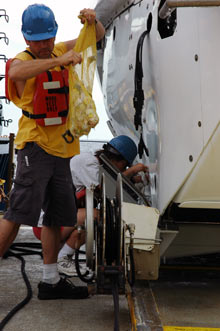View a collection of highlights from the Expedition to the Deep Slope 2006.
![]() Click image to view a slide show.
Click image to view a slide show.
This giant isopod (a crustacean related to shrimps and crabs) represents one of about nine species of large isopods in the genus Bathynomus. They are thought to be abundant in cold, deep waters of the Atlantic and Pacific oceans. Bob Carney of Louisiana State University caught this specimen in one of his deep-water fish traps. Click image for larger view and image credit.
Expedition to the Deep Slope 2006
Mission Summary
May 7 - June 2, 2006
Harry Roberts
Co-Chief Scientist — Deep Slope 2006
Louisiana State University
Since the mid-1980s, when chemosynthetic communities were first discovered in the Gulf of Mexico, most related research has focused on the upper continental slope in water depth less than 1,000 m (3,280 ft). Prior to this cruise, the middle and lower parts of the continental slope were largely unknown and very few sites on the lower continental slope had been visited by a manned submersible or remotely operated vehicle (ROV). Though many new discoveries will be realized only after analyzing the huge quantity of data that we have collected over the past month, we are convinced that this cruise — which used the deep submergence vehicle (DSV) Alvin — has greatly expanded the knowledge of hydrocarbon seeps and associated benthic communities in the deep Gulf of Mexico.
From a logistics perspective alone, this cruise has been a tremendous success. Due to the high cost associated with ship and submersible time, we are always interested in getting as many submersible dives as possible during our limited time at sea. Over the years, we have come to expect a number of planned dives will be lost on each cruise because of severe weather and mechanical difficulties. It is practically unheard of to get in a dive every day during a long cruise. However, due to the dedication and expertise of the DSV Alvin and the research vessel (R/V) Atlantis crews, as well as a huge amount of luck with the weather, we actually accomplished 25 dives over 24 operating days. Of course, on May 24 one of those dives was aborted due to a mechanical issue immediately after the Alvin submerged. The crew quickly recovered, repaired, and redeployed the sub in time to complete a full dive to the sea floor.
The cruise has also been a tremendous success scientifically. One of the primary objectives for this cruise was to determine the along-slope and cross-slope changes in species diversity and abundance in chemosynthetic communities and their geological settings. Dive sites for this cruise were determined by reviewing 3-D seismic data sets and performing photographic reconnaissance using a digital drift camera. A total of 24 Alvin dives were made at 10 sites. Chemosynthetic communities were found at all of the sites, along with hydrocarbon seepage, carbonates, and occasional brine seeps. Seep-related megafaunal communities were sampled at each site. Bathymodiolid mussels, representing at least four different species, were sampled from every site visited. Vestimentiferan tubeworms were visually confirmed at every site except one, and the tubeworms were collected from seven sites. Four of the 10 sites had diverse and densely populated seep communities and topographically complex sea-floor geology. These four sites became our key sampling locations: Atwater Valley Block 340 (2,200 m depth), Green Canyon Block 852 (1,410 m depth), Alaminos Canyon Block 601 (2,340 m depth), and Alaminos Canyon Block 818 (2,740 m depth).
Two of the most important chemosynthetic faunal groups are the bathymodiolid mussels and vestimentiferan tubeworms. Prior to the Alvin cruise, the depth occurrence interval for Bathymodiolus childressi was established with a range from 500 to 2,200 m. For another mussel, Bathymodiolus heckerae, sample collections made during this cruise extended the depth range for this species. Previously, this species had never been observed shallower than 2,220 m and was never found with B. childressi. This was an exciting find! The mussel with the widest depth range was found to be Bathymodiolus brooksi, which is the most common mussel found in middle and lower slope depths. Based on tubeworm collections, Escarpia laminata was found to be the dominant species below water depths of about 1,400 m. An undescribed species of tubeworm, Lamellibranchia sp., was found to be abundant on the mid-slope between water depths of 1,100 to 2,300 m.
Regarding slope-wide faunal changes, our collections indicated that along-slope changes were not significant, but depth-dependent changes were particularly apparent in the mussels and tubeworms. The communities of organisms associated with tubeworms and mussels at lower-slope seep sites were found to be quite different than upper slope (less than 1,000 m) communities. Gastropods and mollusks are dominant on the shallow slope while brittle stars, holothurians (sea cucumbers), and heart urchins are most abundant in middle-to-lower slope depths. We hope to determine the reason for this phylum-level shift (Mollusca to Echinodermata) before this four-year research project is completed.
In addition to chemosynthetic communities, another focus of this cruise was sampling deep-sea coral communities. Gorgonians were observed at most sites, while large colonies of bamboo corals were present at Alaminos Canyon 645. An extensive coral community, including Scleractinian and hard corals and several octocorals, were observed on large carbonate boulders at Green Canyon 852. A voucher specimen of the hard coral, Enallopsammia rostrata, was collected at a water depth of 1,397 m, which extended the depth range of this species.





























